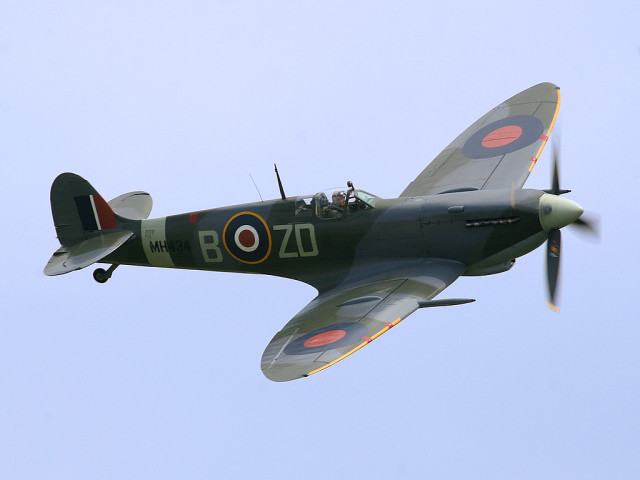
On 5th March 1936, a little four year old girl accompanied her parents and her two younger brothers on a grand adventure. It was nearly 4:30 in the morning and her dad, Ernest Mansbridge, had wrapped his family up warmly, loaded them into his Lanchester 12 motorcar and taken them to Eastleigh Aerodrome to watch the prototype of the Spitfire take to the air for the first time.
The Spitfire was to play a key role during the Battle of Britain and helped to defend Britain against the Nazis, during what Churchill, called its ‘Darkest Hour’.
Judy Monger (nee Mansbridge), now aged 84, recalls sitting in the car watching wide-eyed as the brand new Spitfire plane, painted in blue and silver took off under the control of Captain Joseph “Mutt” Summers for a test flight lasting 20 minutes. Before the plane took off, she remembers the plane’s designer R.J. Mitchell, leaned into the car and chatted to her father who was, at that time an aerodynamicist, working on the design of the Spitfire. The distinctive roar of the engines and the romance of that first flight encouraged Judy to qualify as a pilot as well as make her career as a flight test analyser.
At the 80th Anniversary of the inaugural flight and as part of the Battle of Britain Anniversary celebrations, she had been invited back to the same airport, now named Southampton Airport, to watch a fly by from the Spitfire. She is the last surviving spectator from that historic first flight.
Her recollection of the day is still clear in her mind and she said, “The pilot climbed in the plane, it started with that wonderful sound and then it taxied out. It took off down the runway and up in the air and flew over the railway sheds. It went off for 20 minutes and it came back, flew over and it landed. The pilot climbed out and father and others went and heard what he had to say. It was superb. It was just like it was today. It started with a spurt from the exhaust and climbed away. It is music, it is a magnificent sound.” This plane crashed at Farnborough, the day after war was declared in 1939, killing the pilot, Flight Lieutenant Spinner White.
Other Spitfires that took part in the celebration flew from other airfields. Matt Jones, who aptly described the 50 remaining Spitfires as ‘priceless artefacts”, took the controls of the plane that flew from Southampton Airport in honour of the first test flight. Another two Spitfires took off from Biggin Hill Airport near Bromley and flew over Southampton with the last plane due to fly over Birmingham to pay homage to the factory at Castle Bromwich, in which many Spitfires were manufactured. Unfortunately the flight over the factory had to be cancelled, due to poor weather.
Matt Jones, piloted his Spitfire along a similar route to that taken by the first plane. He flew along the Hampshire coast and turned at Portsmouth to return along the same route. He took the plane past Woolston, Southampton to the old Supermarine factory where thousands of the Spitfires were built and then past the South Stoneham Cemetery, the final resting place of R J Mitchell, the plane’s designer.
Mrs Monger, who attended the celebration with her husband Gordon (90), who was an apprentice at Supermarine at the time the Spitfire was being built there. They watched together as the Spitfire took to the skies, and as the distinctive gurgle of the Merlin engine roared over the airfield she said, “I stood there watching that engine run and I felt my father was stood there next to me being pleased.” Mr Monger was just as choked up as his wife, “It doesn’t seem real to me after all these years. It still looks as marvellous to me as it did all those years ago.”
The manager of the Southampton Airfield, which hosted the celebration, said, “Who would have thought that 80 years after the maiden flight from Southampton Airport of Spitfire K5054, this famous aircraft would still be inspiring new businesses and young people. I am sure that R.J. Mitchell, the chief designer, would be very proud that the Spitfire continues to enthral people today.”
By Original uploader was Bryan Fury75 at fr.wikipedia – Transferred from fr.wikipedia; transferred to Commons by User:Padawane using CommonsHelper., CC BY-SA 3.0, https://commons.wikimedia.org/w/index.php?curid=5200653